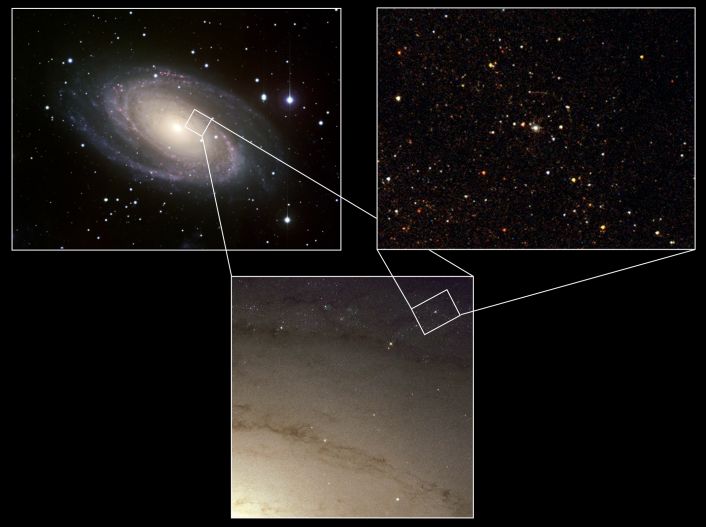
|
Credit & Copyright: Justyn R. Maund (IoA/Univ. Cambridge)
et al.,
ESA
Inset Left: Isaac Newton Telescope, Bottom: Hubble WFPC2, Right: Hubble ACS
Explanation:
Beginning with a full view of beautiful spiral
galaxy M81,
follow the insets (left, bottom, then right) to
zoom in
on a real survivor.
Seen at the center of the final field on the right is a star
identified as the survivor of a cosmic cataclysm --
the supernova explosion of its companion star.
Light from the cosmic blast, likely triggered by the
core collapse of a star initially more than 10 times as massive as the Sun,
first reached Earth over 10 years ago and was
cataloged as
supernova SN 1993J.
Though the supernova itself is no longer visible,
light-echoes from
dust in the region can still be seen near the companion, the first
known survivor of a
supernova
in a binary star system.
Astronomers believe that a substantial
transfer of material
to the surviving companion star during the last few hundred years
before the stellar explosion can explain peculiarities seen
in this
supernova.
After supernova SN 1987A in the
Large Magellanic Cloud, SN 1993J
in nearby M81 is the brightest supernova seen in modern times.
Inset Left: Isaac Newton Telescope, Bottom: Hubble WFPC2, Right: Hubble ACS
|
January February March April May June July August September October November December |
| ||||||||||||||||||||||||||||||||||||||||||||||||
NASA Web Site Statements, Warnings, and Disclaimers
NASA Official: Jay Norris. Specific rights apply.
A service of: LHEA at NASA / GSFC
& Michigan Tech. U.
Based on Astronomy Picture
Of the Day
Publications with keywords: supernova - binary star - SN 1993j - M 81 - SN 1987a
Publications with words: supernova - binary star - SN 1993j - M 81 - SN 1987a
See also:
- APOD: 2025 July 31 Á Supernova 2025rbs in NGC 7331
- APOD: 2025 May 7 Á Galaxy Wars: M81 versus M82
- 38 Hours in the M81 Group
- Messier 81
- APOD: 2023 October 11 Á NGC 1097: Spiral Galaxy with Supernova
- APOD: 2023 July 9 Á Doomed Star Eta Carinae
- APOD: 2023 May 22 Á Supernova Discovered in Nearby Spiral Galaxy M101
